BY STUART MACGREGOR
Kotter's Eight-Stage Journey
Beginning Kotter's eight-stage journey
This is the first in a series of Industry Insights that looks at John Kotter's eight stages of change management, and explores his timeless blueprint for effective change leadership. These change management principles can gel with an enterprise architecture (EA) roadmap to achieve business transformation.
Establishing urgency (stage one) and creating a guiding coalition (stage two) set the foundation for this transformation – moving the company from its current state to a desired future state.
The company's EA practice is viewed as the engine room that powers the move towards transformation, and not the end-goal in itself. However, Kotter's eight stages have a huge role to play in the development of an EA practice.
This is the first in a series of Industry Insights that looks at John Kotter's eight stages of change management, and explores his timeless blueprint for effective change leadership. These change management principles can gel with an enterprise architecture (EA) roadmap to achieve business transformation.
Stage one – establishing urgency
The journey begins with breaking new ground, jolting people out of their comfort zones, and forcing them to deal with often uncomfortable realities. Change, in general, is something people tend to resist – and one of the first tasks for change agents is to overcome the powerful forces of tradition.
This stage requires executives to arrive at a brutally honest assessment of the company as it currently stands. It means exposing issues that may hinder growth and adaption in the future. It involves assessing the market realities, confronting macro, global forces – and identifying all the possible crises, barriers, sources of resistance, as well as potential opportunities.
Most importantly, it requires leaders and change agents to start removing the sources of complacency within the company. In other words, they must refute the reasons that some use to believe change isn't necessary, or that the cost of change will be too great.
Establishing (or reinvigorating) the company's EA practice is vital in making a successful start on the change journey.
EA rises to the fore as the primary toolset that will enable lasting positive change. It guides the company from a state of fragmented applications, organisational structures and processes – and builds an integrated and optimised environment.
In short, EA fuses the business model imperatives and the IT portfolio.
Establishing a sense of urgency among key stakeholders (a process that is triggered by the company CEO) makes the formation of change leadership structures possible. From an architectural perspective, these are bodies like business architecture governance committees, architecture review boards, and IT steering committees.
Without adequate governance, enterprise architecture will remain a theoretical concept that will fail to deliver any transformational business benefits. This, in fact, moves the process neatly on to stage two…
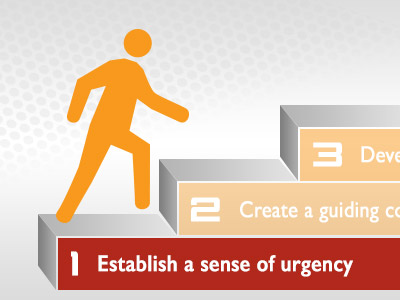
Stage two – creating the guiding coalition
Kotter shows that a strong, core team (the "guiding coalition") lies at the heart of any good change strategy. From there, the message of change radiates outwards to stakeholders throughout the broader company and its extended ecosystem.
Importantly, this coalition must possess people with one or more of the following characteristics:
- Position of power… from executives, to line managers, to others with an influential stature in the enterprise, it is essential to enlist the support of decision-makers at an early stage.
- Expertise… team members with diverse skill sets and points of view, and experience in many of the key areas of the enterprise.
- Credibility… those involved in the coalition need to have strong reputations and the ability to sway the mindsets of others that are hesitant to buy in to the change strategy.
- Leadership… it is essential for the team to include proven leaders who are capable of the kind of visionary, strategic thinking that the coalition will demand.
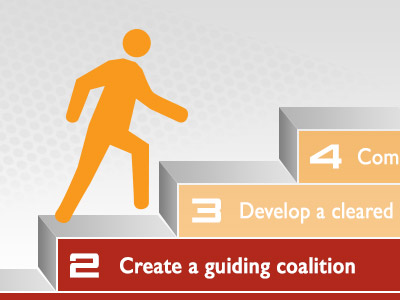
The team is pulled together by mutual trust, a shared vision for the future, and a passion to achieve these common goals. While at this stage the end-state of business transformation may not be in view, there is a shared recognition that the company needs to change the way it operates.
From an EA perspective, this guiding coalition sets the tone where EA starts to be viewed as a business entity of sorts. In a fully functioning EA practice, the company manages its ‘stock in trade' (the corporate intellectual capital), and assembles the various components into EA products and services that address specific stakeholder requirements.
“The business model will work if the various stakeholders within the company receive more value than their perceived cost of contribution"
By starting to run the EA practice as if it was like a business in itself, even at these early stages, the coalition sets out on the right path – one that will eventually see the company formalising and packaging intellectual capital, and turning it into a corporate asset.
The business model will work if the various stakeholders within the company receive more value than their perceived cost of contribution. For example, HR may benefit from having a clear map of everyone's role profile; internal audit may value the accurate view of weaknesses in the company's internal processes. Something of a virtuous feedback loop develops.
Kotter's eight-stage journey continued
The third stage of the change management expedition encompasses the head and the heart.A shared vision A guiding coalition
In my previous Industry Insight, I looked at the first two stages of John Kotter's eight stages of change management, exploring his timeless blueprint for effective change leadership.
In Kotter's third stage – "developing a vision and strategy" – the guiding coalition sets to work on crafting the vision of change and transformation.
This typically runs as an iterative, sometimes even messy, process. Many different perspectives from the various stakeholders are considered, as different role-players provide a number of alternative ways to approach problems and reach goals.
As Kotter reiterates, this is a stage that encompasses both the head and the heart. It is a dynamic process that sees the value of strong teamwork rising to the fore – as the guiding coalition eventually settles on a unified approach..
A shared vision
Because of this complexity, the coalition can take weeks, even many months, to achieve a co-ordinated strategy for the future. Once established, a key contribution of the enterprise architecture (EA) practice is reducing the time taken to produce deliverables – such as the business capability map, for example.
Developing the vision requires the coalition spearhead a number of initial EA work-streams.
To begin with, a set of initial readiness assessments need to be conducted. These provide a clear barometer of where the organisation currently stands, in terms of the maturity and health of its existing EA practice, or its ability to easily embed a new EA framework. The assessments play a vital role in informing the vision for the future state.
Creating a library of definitions is an important early stage activity that ensures all the key stakeholders start from a common understanding of what EA, and a number of other important concepts and terminologies, really means.
Each of these needs to be considered across three dimensions: EA domains, the EA continuum and the EA architecture practice.
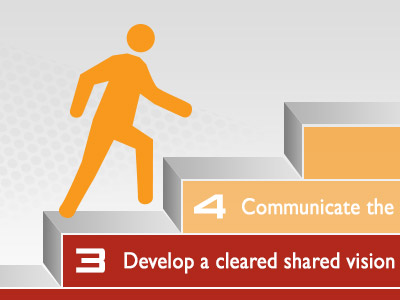
- EA domains consist of business architecture, information architecture, data architecture, applications architecture, and technology architecture.
- The EA continuum considers reference models at a group/enterprise level, an individual business or divisional level, as well as at product application and product focus level.
- The EA architecture practice spans the areas of EA products and services, EA people, EA content (models, principles, standards, inventory, etc), as well as processes and tools.
Guiding principles are formulated across these three dimensions and serve as input to EA vision and strategy.
So, what exactly does the vision need to look like? While there is no singular approach to this, Kotter outlines a number of important characteristics inherent in any good vision that a guiding coalition composes.
He says it must be imaginable, desirable, feasible, focused, and flexible. Finally, it must be simple to communicate (something I will look at more closely in my next Industry Insight).
A guiding coalition
As the vision starts to crystallise, the coalition segments it into different work-streams – and assigns champions to each of these. Having individuals accountable for every aspect of the vision creates a strong sense of ownership, and ensures essential aspects are never overlooked.
It is only by following this thorough approach to developing the vision that the company can address its core system challenges at a root cause level, and overcome the well-worn situation of endless ‘quick fixes'.
It must be imaginable, desirable, feasible, focused, and flexible.
Too often, budget and time constraints force companies to address only the surface symptoms – by implementing disjointed, piecemeal improvements that fail to address the underlying issues, and serve to undermine the company's EA practice.
"Too often, budget and time constraints force companies to address only the surface symptoms"
These kinds of vicious cycles start circling throughout the organisation. As its structures become increasingly dependent on ad hoc quick fixes, they are continually weakened. In today's competitive market environments, this is something that businesses can ill afford to let happen.
But, by following the vigorous approach to strategy and vision creation, the guiding coalition ultimately arrives at a strategic plan that describes how the business will transition, what the end-state will look like, and where investments, energy and focus need to be directed.
As everyone buys into the vision, change agents foster a better understanding of the ‘customer' (internal stakeholders within the enterprise), the ‘products' (the capabilities made possible by the EA practice), and how these products will be structured and packaged to address particular business needs.
Empowering EA
It is critical for the business to communicate the enterprise architecture vision of business transformation.
Following the creation of the enterprise architecture (EA) vision – which I explored in my previous Industry Insight – I now turn to the crucial steps of communicating the vision of business transformation, and empowering broad-based action from the teams required to execute the vision.
From the outset, the guiding coalition is responsible for communicating the EA vision to a nucleus group of stakeholders. As the EA practice develops momentum, the communication emanates outwards, to an increasingly broad group of stakeholders within the business.
Clearly, in this phase, timing is everything.
Over time, the EA practice evolves from its fledgling state to greater levels of maturity. As this happens, the nature of the messages will change.
John Kotter (who advises on the eight stages of change management) says the communication needs to contain the following characteristics:
- Simplicity (eliminating jargon and verbosity);
- Metaphor-rich (pictures are worth a thousand words);
- Multiple forums (leadership sessions, team meetings, newsletters, Intranets, etc);
- Repetition (to reinforce the key messages and ensure they ‘sink in');
- Leadership by example (conduct from leadership that aligns with the communications and messaging);
- Explaining apparent inconsistencies (address everything that seems counterintuitive or illogical, to avoid the communication being undermined); and
- Two-way communication (involving a feedback loop wherever possible greatly increases engagement and empowerment levels).
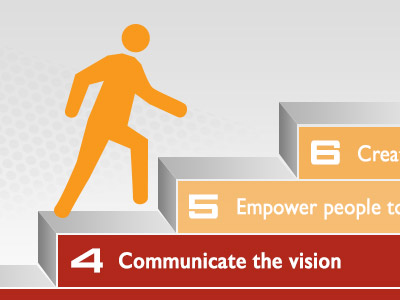
Put simply, the goal of this phase is to ensure the right staff are provided with the right information, at the right time – and empowered to work constructively within the new EA framework.
The advantages of formalising corporate intellectual property and establishing an EA practice need to be clearly articulated – at both an individual level and a company-wide level. If the EA vision is not clearly understood, people will very quickly disengage. They will revert to old habits and frameworks of working, and the timelines for the EA practice to start delivering business value will increase.
"Too often, the coalition becomes overly-enamoured with EA as a discipline – too ‘inwardly-focused' – and forgets about the importance of communicating regularly with key stakeholders, business owners, and decision-makers across the organisation."
Too often, the coalition becomes overly-enamoured with EA as a discipline – too ‘inwardly-focused' – and forgets about the importance of communicating regularly with key stakeholders, business owners, and decision-makers across the organisation.
In fact, there is a continuum, ranging on the one end from the purist that "sits in an Ivory Tower" and becomes too academic and removed from the business, to the other end of the spectrum, with an EA practice experienced in the realities of the company, knows its challenges (eg, political, technical, legacy-related), and takes a pragmatic approach to EA.
The latter is the approach most likely to succeed in generating a sustainable and value-adding EA practice.
Over time, the EA practice evolves from its fledgling state to greater levels of maturity.
Here I use the analogy of running the EA practice like a business in itself: through delivering value to stakeholders one builds a relationship where people willingly engage with the EA practice. In this ideal scenario, positive word of mouth is created – which becomes one of the most valuable forms of internal communication.
Another very impactful form of communicating the vision is when the coalition exemplifies the behaviour it is seeking to establish in others, and ‘leads by example'. By becoming a role model, the coalition is more likely to succeed in its quest to develop new ways of working within the broader company.
But communication alone is not enough. Ensuring the broad-based empowerment of people involves doing the following:
- Teams need to understand the vision for business transformation and the EA value proposition that will enable it. Individuals must internalise this, consider what itmeans to them, and truly buy into the vision. They, in turn, will become ‘marketers' of the company's EA practice – articulating the vision to other stakeholders.
- Teams need to receive quality, comprehensive training on the EA disciplines and activities as they relate to the individual's particular function within the company. They must be empowered with the architecture content that allows them to start harvesting information.
- From there, teams need to populate all of this existing content (such as business strategies, IT strategies, existing applications portfolios, etc) into an integrated EA repository, fully embedded in the organisation.
- An EA methodology – such as TOGAF – is customised and tailored to the company. This means aligning the EA process with the systems development life cycle, strategic planning, corporate governance, and business process improvement, for example.
- Any barriers, at any stage, need to be swiftly removed, so individuals are unleashed to work and to add value within the new framework.
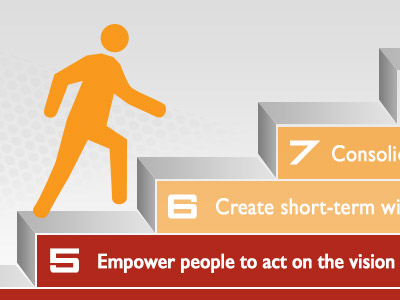
Generating short-term wins
Quick wins, even on a small scale, become the catalyst to building momentum in enterprise architecture.
By this point in the process of business transformation (see my previous Industry Insight), the company has established and communicated the vision for change, and then begun the process of empowering the right teams to start executing on that vision.
Now, as it starts to package some of the early-phase model content, it becomes crucial for the fledgling enterprise architecture (EA) practice to generate some quick wins. Demonstrating tangible business value, even on a small scale, helps to maintain the interest of key stakeholders, and ensures the momentum doesn't start to wane.
In fact, a virtuous cycle should begin to emerge: as the EA practice develops the operational capability to satisfy some business needs, stakeholders begin to recognise the business value. This leads to positive word-of-mouth being spread throughout the company, which in turn stimulates increased levels of demand from various quarters.
Ultimately, this demand translates into increased willingness to invest in the EA journey. With greater levels of buy-in, the EA practice's operational capabilities continue to expand, and the cycle continues.
Success breeds success
Short-term wins become the catalyst to building momentum in EA. John Kotter (who advises on the eight stages of change management) says these early successes are vital for a number of reasons, including the following:
- Providing evidence that sacrifices are worth it: many staff within the coalition and other areas of the business have invested great time and energy in getting to this point.
- Reward change agents with a pat on the back: adding business value is the biggest recognition of success.
- Help fine-tune vision and strategies: insights learned from practically applying EA can be fed back into the strategic thinking.
- Undermine cynics and self-serving resisters: tangible EA successes start to erode the credibility of naysayers.
- Keep bosses on board: maintaining the support of line managers, executives, and other senior stakeholders happens naturally
- Build momentum: more and more people are drawn into the developing EA practice, as people want to associate with a ‘success story'.
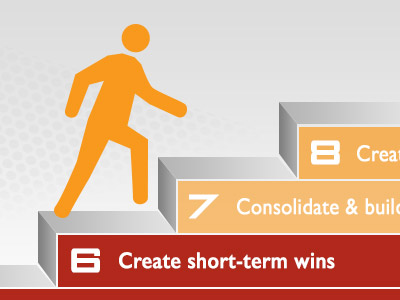
It goes without saying that these short-term wins need to be built on a sustainable and professional EA practice. The foundations must be strong – so the content can be easilyaccessed, and re-used for further process improvement in other areas of the business.
As the demand for business transformation increases, the EA practice needs to manage expectations and delivery. The EA team cannot take on ‘too much' in the early stages, and be seen as the team that slows things down, or hampers innovation and change.
Essentially, the value that stakeholders derive from EA needs to continually exceed their perceived cost of contribution.
As the practice reaches out into the broader company, new opportunities emerge for specialists to contribute their unique insights. To keep the right people on the team, the company also needs to attend to human capital issues, like:
- Ensuring key EA staff members have professional development paths and the opportunities to further their formal qualifications.
- Providing mentoring (from within the organisation, or by pulling in outside mentors).
- Performance management processes that ensure staff are accurately rewarded for their performance.
With the right team in place, the lead architect's focus can shift from the everyday EA operations to higher-value activities. These include continually engaging with executives from across the business – to extend the scope of the EA practice and ensure it remains relevant and value-adding.
The value that stakeholders derive from EA needs to continually exceed their perceived cost of contribution.
The lead architect and the team can concentrate on understanding the potentially disruptive "nexus of forces" (cloud, mobility, big data and social), conducting impact assessments, scenario planning, and implementing new strategies.
The architecture team is then operating on all three levels – strategic, tactical and operational; and facilitating learning across the enterprise.
"The chief architect and his EA team start to position themselves as trusted advisors and business partners to the company – becoming a crucial leadership support function."
In this way, the chief architect and his EA team start to position themselves as trusted advisors and business partners to the company – becoming a crucial leadership support function. Ultimately, the true measure of the EA team's worth is the extent to which the company engages with it, and the extent to which business transformation has been realised.
Making it stick
Shifting from a state of architecture execution to architecture leadership is the next step in the EA journey.
Kotter’s final two stages guide an organisation on the optimum ways that change can be embedded, anchored and matured. From an Enterprise Architecture (EA) perspective, these phases relate to the ‘professionalising’ of the EA practice.
Our previous article looked at generating tangible “early wins” in the EA practice, and how they can echo throughout the organisation, as positive word-of-mouth spreads. The next step is to build on this momentum and to establish EA across every layer of processes, people, content, and tools, and products/services.
So, what are the hallmarks of a mature-state EA practice?
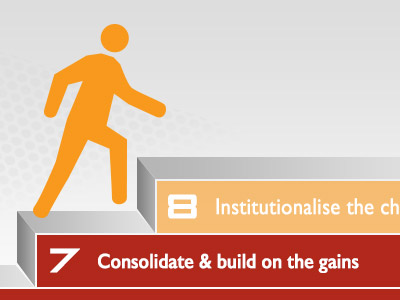
- Entrenching the ethos of "running the EA practice like a business"... The foundation of the ‘business model' includes five process areas: managing the business, enhancing market reputation, winning better business, delivering valued solutions, and growing the EA capability. In this way, resource allocation remains tightly synced with business need.
- Innovation... EA essentially manages intellectual capital as an asset, translating tacit individual knowledge into organisational assets, in the form of models – which fuels constant innovation. Ideas are crowd-sourced from employees and partner ecosystems, and then analysed and prioritised according to business impact.
- Strategic planning is dynamic and living... As intellectual capital becomes formalised as a corporate asset, the company can perform strategic planning at a higher level. This enables it to respond with agility to any changes in the external environment, as well as evolving business models within the company walls.
- Business processes and capabilities become optimised… integrated business processes are naturally (willingly) enforced across the business. Process owners and system custodians focus on the right business capabilities and continually optimise processes.
- Investment... The organisation targets its technology investment on IT assets that support identified and measurable business objectives, all within the framework of EA.
"a shift from a state of 'EA execution' to what can be referred to as 'architecture leadership'"
These fundamentals represent a shift from a state of "EA execution" to what can be referred to as "architecture leadership".
In this state of advanced EA maturity, EA should also be repositioned and de-coupled from the IT department. Ideally, EA practice leaders should be moved to the office of the CEO, reporting to a function such as transformation management.
One of the most important facets of successfully transitioning from isolated early wins to EA leadership, which is embedded throughout the company, is ensuring key people are retained. The departure of important individuals can have catastrophic consequences at this stage – meaning EA never becomes entrenched.
For this reason, successful business leaders place a high emphasis on training, mentoring and further developing the EA teams. As ambitions soar, and people develop a passion for EA, industry bodies like The Open Group provide a useful outlet for this energy.
Companies in almost every sector, and all around the world, are being asked to reinvent themselves continually in order to survive.
By contributing to the industry standards that are developed by The Open Group, individuals enjoy a greater sense of purpose – a tangible feeling that they are working on
These fundamentals represent a shift from a state of "EA execution" to what can be referred to as "architecture leadership".
In this state of advanced EA maturity, EA should also be repositioned and de-coupled from the IT department. Ideally, EA practice leaders should be moved to the office of the CEO, reporting to a function such as transformation management.
One of the most important facets of successfully transitioning from isolated early wins to EA leadership, which is embedded throughout the company, is ensuring key people are retained. The departure of important individuals can have catastrophic consequences at this stage – meaning EA never becomes entrenched.
For this reason, successful business leaders place a high emphasis on training, mentoring and further developing the EA teams. As ambitions soar, and people develop a passion for EA, industry bodies like The Open Group provide a useful outlet for this energy.
Companies in almost every sector, and all around the world, are being asked to reinvent themselves continually in order to survive.
By contributing to the industry standards that are developed by The Open Group, individuals enjoy a greater sense of purpose – a tangible feeling that they are working on
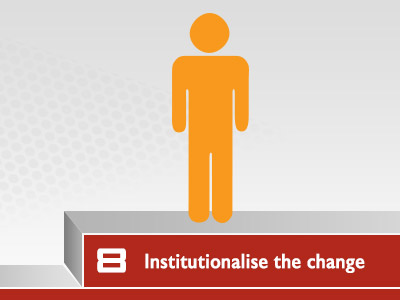
"a virtuous cycle develops momentum: more and more ‘customers' within the company start benefiting from EA, and more and more people are willing to invest in it"
As the success of the EA practice continues and the solution base expands, a virtuous cycle develops momentum: more and more ‘customers' within the company start benefiting from EA, and more and more people are willing to invest in it.
The change process speeds up and becomes smoother; the ambit of EA broadens, and starts to influence every aspect of the business – including things like strategy planning, risk management, business transformation, and even mergers and acquisitions.
The essence of EA – that of managing complexity and change – is never forgotten. This new world requires new ways of thinking to address challenges and grab opportunities. Simply put, firms that continue to perpetuate old practices, will be left in the dust.
We’ll leave you with one of the pioneers of EA, John Zachman, who succinctly describes this essential fact:
“Increasing flexibility and reducing time to market… will only happen with responsible and intellectual investment, in developing and maintaining Enterprise Architecture, to deliver quality information, to produce a quality enterprise.”


